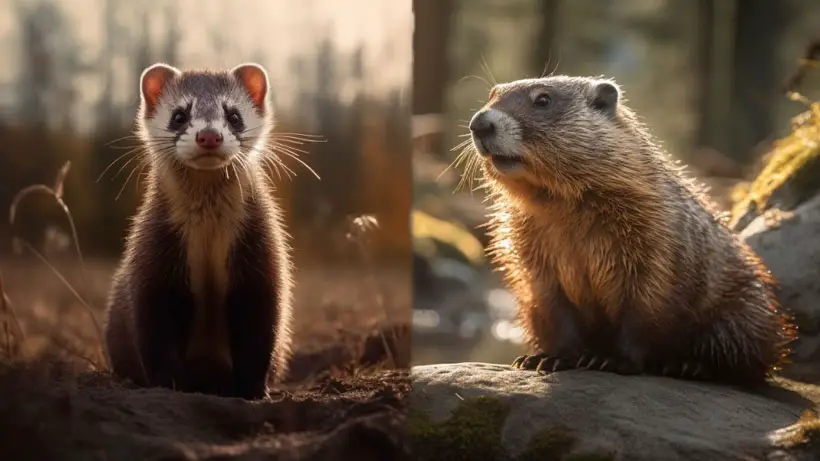Marmot vs Ferret: Behavior, Habitat, and Physical Characteristics
Marmots are large squirrels from the Sciuridae family native to the mountainous regions of Europe, Asia, and North America. Meanwhile, ferrets are small, furry domesticated animals and members of the Mustelidae family. Like marmots, ferrets are native to Europe, North America, and Asia. They live in open grasslands, forests, agricultural areas, plains regions, and deserts.
Like other animal species, marmots and ferrets differ in many ways, including their physical adaptations. So, understanding their differences is critical for conservation efforts as both species are vulnerable to loss of habitats. In addition, understanding their differences is crucial in appreciating their unique qualities and behaviors.
So then, how do marmots differ from ferrets apart from their habitats? Below is all you need to know about their physical attributes, behaviors, and even pet ownership.
Ferrets Vs. Marmots: Physical Characteristics
The major differences between ferrets and marmots are their physical features. Let’s check them out.

Size
The common marmot physical characteristics vs. ferret physical characteristics that make them different is size. Typically ferrets measure between 15 and 20 inches long from the head to the tail.
Marmots are larger than ferrets, measuring between 17 and 28 inches long. In the case of both animals, the males are more enormous than the females.
Weight
Fully-grown female ferrets weigh between 1.75 and 3.5 pounds, while the males are about 3 and 5 pounds heavy. However, a neutered ferret weighs less than its unaltered counterpart.
On the other hand, marmots weigh between 3.5 and 11.4 pounds, depending on the species. So, apart from them being bigger, they are also heavier than ferrets.

Fur Color
Ferrets come in many color patterns. The typical fur color is sable or brownish, but the undercoat is slightly pale. Other fur colors are chocolate, albino, cinnamon, black sable, and champagne. The fur color of marmots also differs from the usual shades of brown and gray among the different species. They also boast splotches or streaks of yellow, reddish brown, white, or black. Their color patterns usually change throughout the year, and their appearance is nearly similar to that of groundhogs.

How Physical Characteristics May Aid in Survival in Their Respective Habitats
Ferrets boast long, slender bodies that enable them to quickly crawl in and out of burrows where they live. Their slim body also allows them to move swiftly through narrow spaces in their arboreal habitats. In addition, these exotic animals have dense fur that offers insulation against cold temperatures. This adaptation comes in handy for wild ferrets inhabiting habitats with colder climates.
Meanwhile, marmots’ large body size allows them to survive in the low temperatures and high-elevation habitats in which they live. This is because their large size increases their fat accumulation efficiency, which they use as their sole energy source. In addition, these rodents have thick fur to protect them from the cold. This helps them survive the harsh winters in their habitats.

Additionally, the ferrets’ and marmots’ fur color also aids in their survival. It enables them to blend in with their surroundings helping them avoid predators.
Marmot Vs. Ferret: Behavioral Differences
Marmots and ferrets boast distinct habits. So, here is a comparison of marmot behavior vs ferret behavior.

Territoriality
Male marmots are exceedingly territorial in their burrows. Generally, one male may defend a group of females in a single colony. Besides flagging their tails to advertise their presence, male marmots usually mark their territories using their scent.
Like marmots, ferrets also have territorial animal behavior, marking their territories via scent. Apart from the face, ferrets have scent glands on their anus and feet. Their anal glands usually release a strong musky odor. In addition, ferrets may urinate or defecate in certain areas to mark their territories.
Communication
Marmots communicate through scent marking, body language, and vocalizations. They use scent markings to warn other marmots of their presence. Regarding body language, these animals may flick their tail when annoyed or chatter their teeth as a threat to intruders.
Additionally, marmots make many calls to communicate. These include whistles, trills, screams, chucks, and alarm calls. They usually make these calls to signal a potential danger or communicate with each other during the mating season.

Like marmots, ferrets also use scent, vocalizations, and body language to communicate their mood and feelings. For example, they may wag their tails, bounce, hop, or roll over when happy, excited, or relaxed. But when feeling threatened, they may arch their backs.
Additionally, ferrets have a range of vocalizations ranging from hissing to barking, squeaking, and screeching. They also make loud chirps, clucking, and dooking noises when scared or excited.
Mating
Most marmot species are primarily monogamous, pairing up with one mate every breeding season. However, yellow-bellied male marmots are polygynous, mating with 2 or 3 females at once.
Typically, mating occurs once a year in spring after emerging from hibernation. The female marmots usually give birth in an underground den after about a 30-day gestation period. They may have a litter of 3 to 8 pups.
A majority of ferret species are polygynous. They mate with numerous females near their territories. Like marmots, ferrets also breed in late winter and early spring. In addition, they mate once per year, and their gestation period is about 41 days. Meanwhile, their average litter size ranges from 4 to 8 kits.
Comparison of Marmot and Ferret Behavior in Captivity
Marmots are not kept as pets. But when kept in captivity for conservation purposes, marmots may exhibit some natural behavior adaptations, like foraging for food. This happens when they are kept in large enclosures with access to outdoor spaces. It may also occur when the marmots are provided with environmental enrichment.
The males may also engage in territorial displays to attract a mate and establish their dominance. In captivity, marmots also communicate through vocalizations, body language, and scent marking.

Unlike a marmot, you can keep ferrets as pets. In captivity, they tend to retain most of their natural behaviors. For example, they are very territorial. Typically, ferrets define their territories by backing into corners to defecate. This marking is usually followed with an anal drag.
Additionally, captive ferrets use a range of vocalizations and body language to communicate their feelings. Regarding mating, ferrets in captivity may reproduce more often because of access to abundant food, water, and shelter. Also, they may mate at any time of the year.
How Behavior Differs in Their Natural Habitats
Marmots live in large colonies in their natural habitats. Meanwhile, wild ferrets generally live in small family groups.
Additionally, marmots are mainly diurnal and hence are active during the day. On the other hand, ferrets are nocturnal and hence are active at night.

While marmots mate in spring, ferrets may mate in late winter or early spring. Also, ferrets have a longer gestation period than marmots.
Marmot Vs. Ferret: Range and Habitat Preferences
Marmots and ferrets boast different habitat preferences. For example, marmots are endemic to the north of Mexico and Eurasia. They live in cold mountainous regions, such as the Tatras, the Himalayas in Asia, and the Alps in Europe.
Generally, they prefer habitats with abundant vegetation. These include the plains, edges of forests, tundra, steppes, rocky areas, meadows, and talus slopes.
On the other hand, ferrets are commonly found in Europe, North America, and Western Asia. In addition, they live everywhere, from the forests to mountainous regions, grasslands, swamps, and deserts. They also inhabit the plains areas, farmlands, tundra, and steppe.

For pet ferrets, their best habitats are large and well-ventilated wire cages that enable them to burrow, run, and climb.
Comparison of the Differences Between Marmot and Ferret Habitats
Overall, ferrets have a wider range of habitats than marmots. Generally, marmots often live in mountainous areas and grasslands. On the other hand, ferrets can live in captivity, wetlands, agricultural areas, deserts, grasslands, and forests.
Another difference between a marmot habitat vs. ferret habitat is adaptation. For example, marmots are adapted to living in cold climates, while ferrets can live in a range of environments. This includes both warm and cold conditions.
Impact of Habitat Loss on Marmot and Ferret Populations
One significant impact is a reduction of food sources, leading to increased competition for resources. As a result, marmots’ and ferrets’ survival rates may decline. Habitat loss may also lead to reduced reproduction success because of reduced safe breeding sites for these animals.
Additionally, the loss of their habitats may lead to increased predation risk in the wild, especially for marmots. This is because they rely on thick vegetation to stay away from most predators. Due to increased predation, their populations may decline.
If you’re curious about marmots and want to learn more about them, check out our articles on what marmots look like and how to get rid of marmots. Our article on what does a marmot look like provides a detailed description of marmot physical characteristics, including size, shape, and color. Meanwhile, our article on how to get rid of marmots offers tips and advice for preventing and eliminating marmot infestations.FAQs
In this section, we will respond to some frequently asked questions regarding a marmot vs ferret. Check them out.
Can marmots and ferrets be kept as pets?
Ferrets can be kept as pets because of their charming and sociable character. However, marmots cannot. In fact, most species of marmots are protected by law, making it illegal to rehabilitate them.
What should I do if I find a marmot or ferret in the wild?
The best thing is to observe the animal from a distance without disturbing it. After all, they are wild animals and can become aggressive if they feel cornered or threatened.
Are there any legal restrictions on keeping marmots or ferrets as pets?
Yes. There may be some legal regulations on keeping these animals, depending on the country or state you live in. But in many places, you cannot keep marmots as pets. Meanwhile, you can keep ferrets as pets, but their ownership may be regulated in some areas.
Conclusion
The fundamental differences between ferrets and marmots are their physical characteristics. These animals also differ in their habits, like how they communicate, mate, and their territoriality. Their habitats also differ.
Now, understanding the differences between marmots and ferrets is essential for several reasons. First, it may help people better appreciate the unique features and adaptations of both species.
Secondly, it can help inform better conservation efforts of these animals and their habitats. And thirdly, it could help people avoid unintentional harm to these species.
With that said, more research is needed regarding the wildlife behavior of each species, conservation status, and their interactions with other animals. Finally, it is important that people appreciate both species in their natural environments by taking guided tours and supporting conservation efforts.




